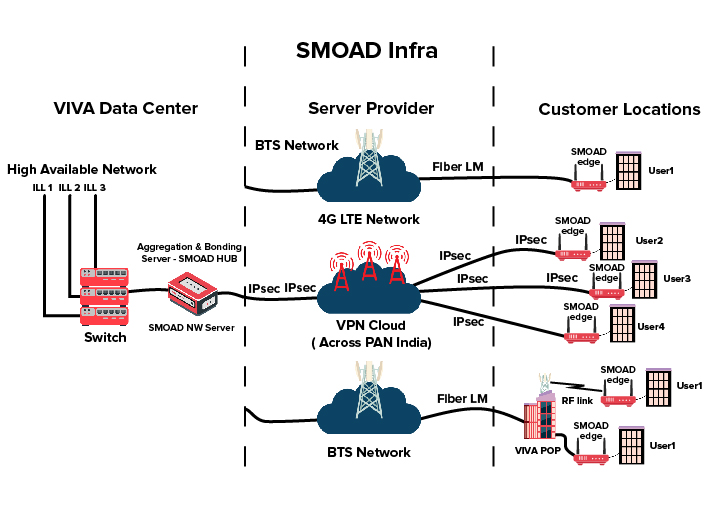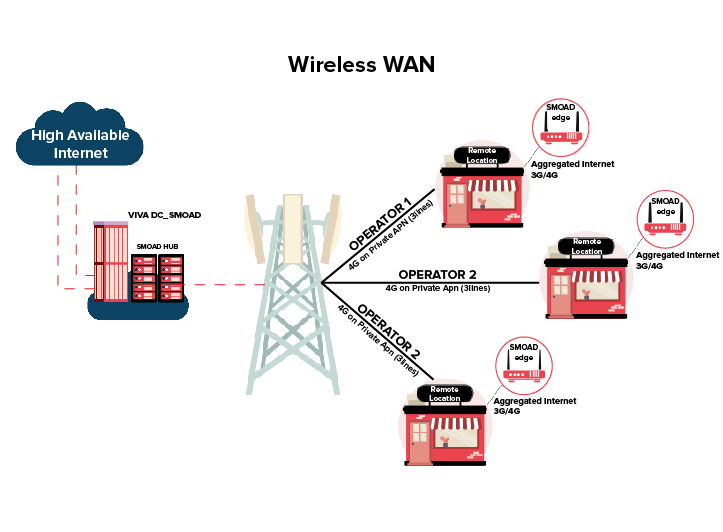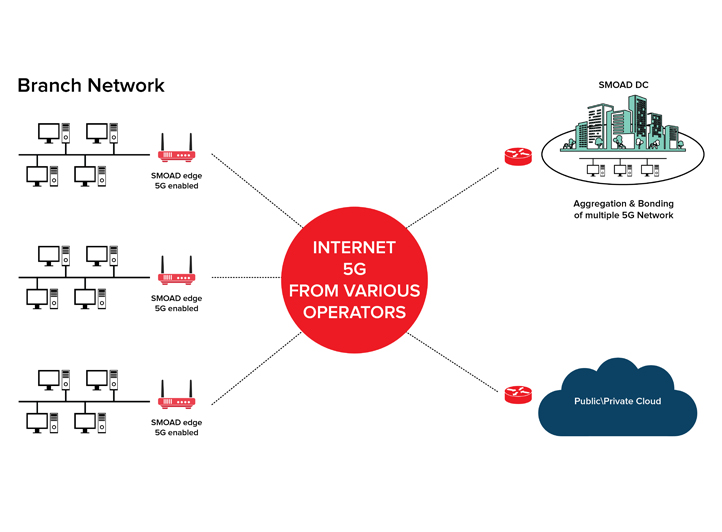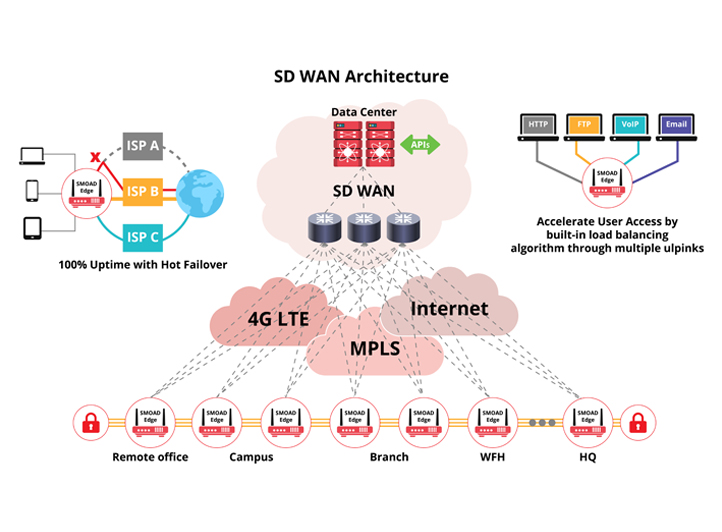SMOAD Infrastructure
SMOAD specializes in software defined networking and connectivity solutions. Our USP has been aggregation of multiple networks like multiple 4G LTE, Broadband, RF, or any data transport using an indigenously designed router, ensuring 99.99% uptime with seamless failover.
The SMOAD network appliance enables enterprise branch offices to have reliable high performance data connectivity to their main head quarter office datacentres and to the public internet. Each branch office is enabled with a fast internet pipe by bonding multiple cost-effective transport technologies such as mobile networks via SMOAD. The internet lines to be bonded may be from different carriers for ISP diversity to increase reliability.
Additionally, leveraging the high bandwidth connectivity present at the main office of the enterprise, SMOAD provides the branch office facility with reliable, high performance Internet access at a fraction of the cost of single provider solutions.
Virtual Leased Line (VLL) enables bonding of multiple Internet access resources such as DSL/Broadband, ILL, multiple 4G LTE or any other IP transport, to provide reliable high throughput data channels. SMOAD Server can be installed at the main-office/data-centre (master unit) and at a branch office as illustrated below. This architecture will enable a high-speed IP communication framework between the branch office and the headquarters, as well as between the branch offices.
Wireless WAN
Wireless WAN stands for Wireless wide area network. The wide area network is larger than a traditional Local Area Network (LAN) which usually spans across few systems inside a building. Usually, Wireless WAN uses various telecommunication network technologies.
One of the types of Wireless WAN is Mesh Networks. In case of mesh network, various network elements, connect with each other as an independent entity. They have the ability to communicate amongst them and can also self-organise.
Using a mesh-network based Wireless LAN solution, SMOAD can provide internet access in remote locations around the world. While many SMOAD routers can be connected to provide wired/wireless access, one SMOAD router can be used as the primary device which connects to the Internet. This connection can use one or more service providers and provide a high-available access to the Internet.
Our SMOAD devices uses routing technique to pass a message from a connected device to the internet and vice versa through a series of hops from one SMOAD device to another, until the message is successfully passed. In case a device goes down then the network self-organises to reroute the traffic through a different pathway.
5G Ready
SMOAD Network devices uses proprietary technology to aggregate several internet connections’ bandwidth and route the network traffic intelligently. The various connections can be 3G, 4G or even 5G connection.
5G stands for fifth generation. With 5G, the speed of communication is expected to increase significantly compared to the current 4G LTE. Also, with 5G the latency – the time taken between requesting a resource, say, a file or video from the internet and receiving it – is expected to come down significantly (around 1 milliseconds). This would change the way many companies operate. They no longer need to have high power system on their premise as they can move them all to a nearby data centre.
SMOAD has the ability to run multiple Virtual Machines at the edge level already. This gives SMOAD an advantage to perform various functions at the device itself. Also, the technology used for aggregation of wireless / wired connection is generation agnostic. So, when 5G comes in, SMOAD devices can take advantage of it right from Day 1.
Fixed Wireless Access
Fixed wireless is the facet of wireless communication used to connect two fixed locations with a radio or wireless link. Usually, Fixed Wireless Access is provided between two locations to enable data communications between them. This is a cost-effective approach compared to having a wired solution (Cost increases with increase in distance).
Fixed Wireless solutions involve using directional radio antennas on either endpoint for communication. These antennas are usually certified for outdoor use and can withstand varying external factors such as temperature, wind, humidity, etc., while managing to provide necessary bandwidth across large distances.
Fixed Wireless Access usually provides point-to-point access and one location can be connected to a company’s internal network and / or to outside internet. With necessary security setup and network configuration in place, this setup would provide an extended Local Area Network (LAN) facility for sites / buildings which are further away from central buildings.
With licensed frequencies, these setups can provide a high Quality-of-Service and higher throughput as well.
Software Defined Wide Area Network (SD-WAN)
Traditional Wide Area Network (WAN) are used to provide connectivity between branch offices and headquarters. In the recent years, there has been a constant increase in usage of high bandwidth demanding applications. This makes the CTOs worry about Quality of Service (QoS) issues like latency, jitter, and pack loss. The solution involves constant upgrades of routers at branch offices. This is a complex, costly and time-consuming process.
SD-WAN (Software Defined Wide Area Network) solution involves using commercially available off-the-shelf components as network devices. The networking features are defined at the software level as network overlay. This simplifies the setup, management, and upgrade of network devices at the branch offices. It also enables a centralised management and enables frequent updates at lesser cost.
SMOAD (Software Defined Mobile Aggregated Data) is the next generation SD-WAN based solution. It aggregates bandwidth across mobile uplinks as network overlay with control functions. This provides redundancy, higher bandwidth, and smoother traffic flow.






